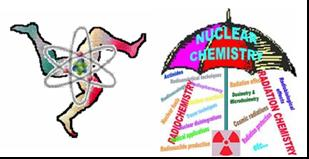Speaker
Mrs
Ewa Tomankiewicz
(Institute of Nuclear Physics, PAS, Radzikowskiego 152,31-342 Kraków, Poland)
Description
This poster presents results of application of a sequential radiochemical procedure for multi-elemental analyses for samples human bones obtained from joint replacement surgery.
The grounded ashes of bones were dissolved in 6mol/L HCl. Samples were left for two days until bubbles disappeared. The tracers, i.e. 242Pu, 243Am and 85Sr, were added using an automatic pipette and analytical balance to determine the mass of the tracer solutions added. After complete dissolution two subsequent precipitation of calcium oxalates was completed to obtain two fractions: 1) transuranic (Pu+Am) and 2) strontium at pH 3 and 6, respectively.The pH was adjusted using ammonia. The centrifuged transuranic fraction was re-dissolved and oxalates were precipitated again at pH=3. It was performed to remove traces of phosphates which may cause problems during the anion-exchange procedure on Dowex-1 resin. In both fractions the oxalates were destroyed with hot concentrated nitric acid. The solutions were evaporated to dryness.
Each transuranic fraction was dissolved in 100 mL of 1 mol/L HNO3. The oxidation state of Pu was adjusted to +4 using hydrazine and NaNO2 and after filtration and conversion into 8 mol/L HNO3, the fractions were passed through Dowex-1x8 (100-200 mesh). Am passes the column without retention. Th which together with Pu remains in the column, was eluted with 12 mol/L HCl and then Pu was eluted using 50 mL of 0.1 mol/L HF-0.1 mol/L HCl. Effluents containing Am ions were evaporated nearly to dryness, then diluted and next Am was co-precipitated with Fe(OH)3 at pH=9 adjusted using ammonia. Each centrifuged residue was dissolved in 4 mol/L HNO3 and passed through conditioned TEVA column (by Triskem International) to remove traces of Th. Am was separated from any traces of rare-earth elements using methanol-acid solutions. Both Pu and Am sources were made using NdF3 method and were measured using alpha spectrometer with Canberra PIPS detectors.
Each Sr fraction was dissolved in 100 mL of 3 mol/L HNO3, filtrated and then directly passed through the conditioned Sr-Resin (by Triskem International) column. After washing the column with 20 mL of 3 mol/L HNO3, strontium was eluted using 30 mL of deionized water, evaporated and purified from traces of 210Pb. The purified Sr solutions of 3 mL of 0.5 mol/L HNO3 were transferred into a LSC vials and following determination of 85Sr recovery by means of gamma-spectrometry, they were stored for at least 2 weeks to achieve equilibration between 90Sr and 90Y. Finally, each of the solutions was mixed with 10 mL of HiSafe3 liquid scintillation cocktail and measured using Wallac 1414 Guardian LSC spectrometer.
The radiochemical procedure described above was developed over more than 10 years, and we profited much from the experience we gained while completing many projects on Pu, Am and Sr determination in animal bones Due to world-wide shortage of animal bones reference materials (RM) in many of our projects, the soil matrix RMs were applied instead. However, the RM by NIST SRM Ash Bone 4356 have been recently certified for Pu isotopes and 90Sr. This material, as well as IAEA soil-375, were thus analyzed to assure the measurements quality.
Author
Prof.
Jerzy Mietelski
(Institute of Nuclear Physics, PAS, Radzikowskiego 152,31-342 Kraków, Poland)
Co-authors
Prof.
Edward Golec
(Traumatology and Orthopaedic Clinic, 5th Military Clinical Hospital and Polyclinic, Independent Public Healthcare Facility, Wrocławska 1-3, 30-901 Kraków, Poland)
Dr
Elżbieta Szczygiel
(Physical Therapy Department, Institute of Physical Therapy, Faculty of Heath Science, Jagiellonian University, Medical College, Kraków, Poland)
Mrs
Ewa Tomankiewicz
(Institute of Nuclear Physics, PAS, Radzikowskiego 152,31-342 Kraków, Poland)
Dr
Joanna Golec
(Orthopaedic Rehabilitation Department, Chair of Clinical Rehabilitation, Faculty of Motor of the Bronislaw Czech University School of Physical Education, Kraków, Poland)
Mr
Kamil Brudecki
(Institute of Nuclear Physics, PAS, Radzikowskiego 152,31-342 Kraków, Poland)
Dr
Sebastian Nowak
(Traumatology and Orthopaedic Clinic, 5th Military Clinical Hospital and Polyclinic, Independent Public Healthcare Facility, Wrocławska 1-3, 30-901 Kraków, Poland)
